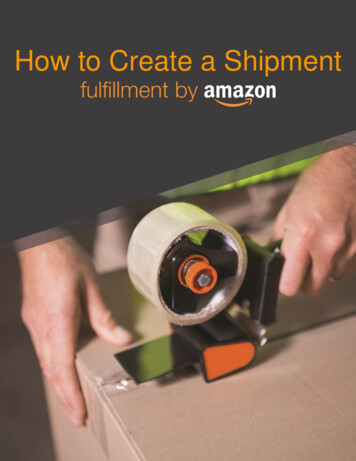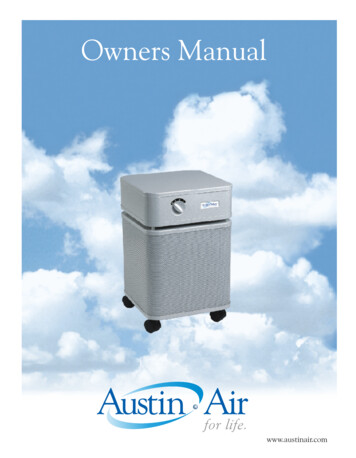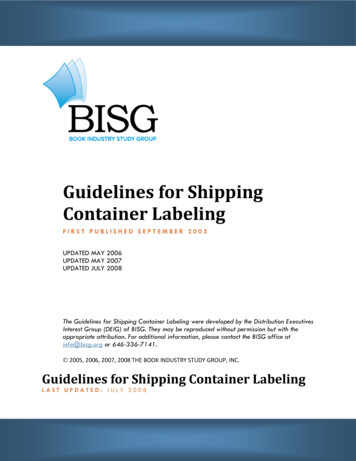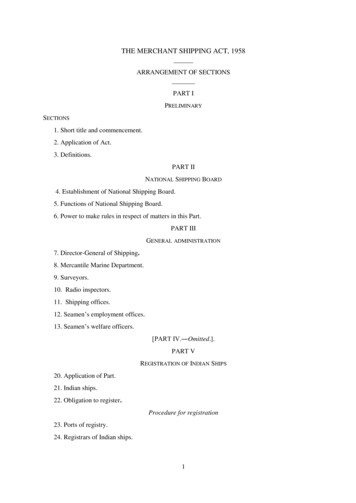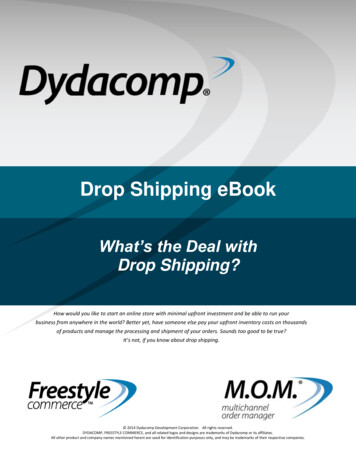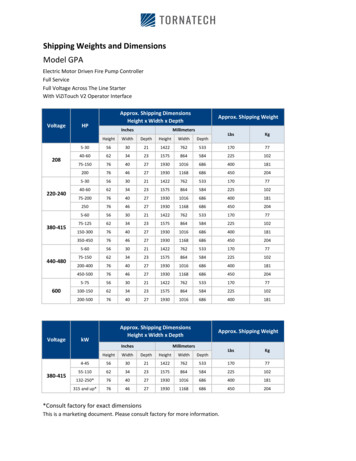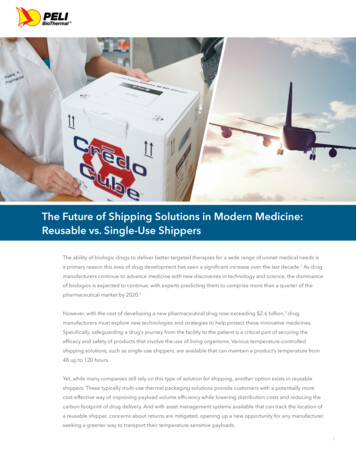
Transcription
The Future of Shipping Solutions in Modern Medicine:Reusable vs. Single-Use ShippersThe ability of biologic drugs to deliver better targeted therapies for a wide range of unmet medical needs isa primary reason this area of drug development has seen a significant increase over the last decade.1 As drugmanufacturers continue to advance medicine with new discoveries in technology and science, the dominanceof biologics is expected to continue, with experts predicting them to comprise more than a quarter of thepharmaceutical market by 2020.2However, with the cost of developing a new pharmaceutical drug now exceeding 2.6 billion,3 drugmanufacturers must explore new technologies and strategies to help protect these innovative medicines.Specifically, safeguarding a drug’s journey from the facility to the patient is a critical part of securing theefficacy and safety of products that involve the use of living organisms. Various temperature-controlledshipping solutions, such as single-use shippers, are available that can maintain a product’s temperature from48 up to 120 hours.Yet, while many companies still rely on this type of solution for shipping, another option exists in reusableshippers. These typically multi-use thermal packaging solutions provide customers with a potentially morecost-effective way of improving payload volume efficiency while lowering distribution costs and reducing thecarbon footprint of drug delivery. And with asset management systems available that can track the location ofa reusable shipper, concerns about returns are mitigated, opening up a new opportunity for any manufacturerseeking a greener way to transport their temperature-sensitive payloads.1
The Future of Shipping Solutions in Modern Medicine: Reusable vs. Single-Use ShippersTHE ENVIRONMENTAL IMPACT OFSINGLE-USE VERSUS REUSABLE SHIPPERSTraditional single-use packaging containers rely on layers of insulation comprised of either polyurethane(PUR) or extruded polystyrene (EPS) insulation and gel pack heat sinks to maintain product temperaturesthroughout shipping. These materials allow for temperature control between 24 and 72 hours. At the end ofthe single-use shipper’s journey, all components of the container, except for most of the cardboard corrugate,are sent to a landfill. Reusable shippers, though, are constructed with high-end vacuum-insulated panelsand phase change materials (PCMs) contained in some fashion, i.e. bottles, etc., that are returned to themanufacturer’s service centre for inspection, cleaning, and general prep for next use once their journeyis complete. These shippers can maintain a 2º to 8º Celsius temperature range for up to 96 hours andsometimes beyond.In the controlled setting of the Goellner study it was found that reusable shippers also weigh less and haveconsiderably larger usable payload space (due to the thin, yet efficient insulation compared to thick-wallsingle-use shippers), which means they can hold a financial advantage when it comes to transportation andstorage costs. Nevertheless, the most noteworthy advantage reusable shippers have is the benefits they offerwhen it comes to lightening the environmental burden other shippers may impose.4Reusable Shippers:CREATELESS WASTESingle-use shippers end upin a landfill.REDUCETRANSPORTATIONCOSTSReusable shippers weigh lessand conserve space.2
The Future of Shipping Solutions in Modern Medicine: Reusable vs. Single-Use ShippersGOELLNER STUDYTo review the environmental impact between the two shipping options (reusable versus single-use), a studywas performed over the course of two years for a pharmaceutical clinical trial requiring individual shipmentswithin the contiguous United States.4 It is the first to focus on thermal packaging used in cold chain logisticsfor the life sciences industry.5 Looking at the carbon footprint of the reusable and single-use options fromcradle-to-grave, Goellner assessed the global warming, eutrophication, acidification, photochemical oxidationand human toxicity potential, as well as the amount of postconsumer waste of the two shipping solutions.Emission calculations use an equally weighted function of mass and distance, so the weight differencebetween the two solutions became a key factor in determining their environmental impact.The single-use container used for this study—made up of insulation, gel packs, gel bricks and corrugate—hada total weight of 17.85 kilograms (kgs) when PUR was used and 19.07 kgs when EPS was used. The reusableshipper’s weight, which totaled only 9.49 kgs, included the vacuum-insulated panels, thermal insulationchamber, phase change materials, outer corrugate and tape. Over the course of the study, 30,000 single-useshippers were required to satisfy the clinical trial material needs, as opposed to only 772 reusable shippers.After two years, the reusable shippers had emitted 241 tonnes of carbon dioxide (CO2) during transportversus 1,122 tonnes from the single-use shippers. According to Goellner, this is roughly a 75 percentdifference in global warming potential between the two approaches. In addition, the reusable approachshowed 60 percent less acidification potential, 65 percent less eutrophication potential, 85 percent lessphotochemical ozone potential, 85 percent less human toxicity potential and 95 percent lesspostconsumer waste.According to a Goellner study, reusable shippers show:75%60%65%lessGLOBAL POTENTIALlessHUMAN TOXICITYPOTENTIALlessPOSTCONSUMERWASTE3
The Future of Shipping Solutions in Modern Medicine: Reusable vs. Single-Use ShippersThe study also considered the return rate of the reusable containers. Though the initial investment for themis higher than that of a single-use container, a manufacturer receives a return on their investment over timeas the shipper is returned after every shipment for reconditioning and reuse.6 Over the two years followingthe reusable shippers, Goellner assumed they were shipped twice a month with a 90 percent annual recoveryrate.7 Ensuring a successful recovery rate of a reusable shipper such as this is dependent on a reliable assetmanagement system, integration with carriers and enterprise resource planning (ERP) systems and opencommunication and cooperation between supply chain stakeholders.MANAGING THE RETURN OF REUSABLE SHIPPERSWhen utilising reusable shippers, getting the containers back is critical not just to avoid delays in shippingyour products to the patients who need them but also to your bottom line, as one pharma company foundwhen it discovered it had a large number of shippers sitting at its delivery location in Asia.8 Upon discoveringthis need to track its reusable shippers, the company contacted Peli Biothermal (PBT) to implement assetmanagement software and organise the return of their containers.First, the company worked with its local vendor for each country in the region to send shippers to aconsolidation facility. Each reusable shipper at PBT is equipped with a bar code and identification number(similar to the vehicle identification number on a car). That bar code is scanned into the software and, byintegrating with carriers like FedEx, DHL and UPS, the shipper’s country of origin, each stopping point in itsroute and, finally, when it arrives at the consolidation facility can all be tracked by PBT. The company and thevendors worked together to monitor the returns coming from the consolidation facility and the rate at whichthey were being returned. To date, the use of PBT’s asset management software has organised the returnof over 1,200 shippers to the client, resulting in a savings of over 120,000 in the first year and 200,000 insavings in each year after.Monitoring the return of reusable shippers:Peli BioThermal’sasset management softwarehas ensured the return of over1,200 SHIPPERSThat means 120,000of savings in year one and 200,000in savings each year after.4
The Future of Shipping Solutions in Modern Medicine: Reusable vs. Single-Use ShippersThe benefit of the software is not limited to managing the return of shippers. The data from the scanned barcodes also provides the shipper recovery rate, number of uses, the damage rate (to determine amount oftotal repair costs) and average lane length. Not only does this provide supply chain transparency that is vitalto tracking and protecting a drug product shipment, but it can also help when determining if and wheretemperature excursions may have occurred. For example, if an asset is qualified to be in a shipping lane forfour days but the tracking information shows it took eight days for delivery, the customer can look back at theroute and pinpoint where something went wrong. Identifying when and where errors occurred is vital duringan investigation, so corrective measures can be put in place to prevent them from happening again. Standardindustry performance qualification and cleaning ensures reusable shippers can deliver consistent results overthe lifetime of the equipment, which is typically about five years.As the pharmaceutical industry continues its pursuit of new therapies for unmet needs using biologic drugs,manufacturers will need to lean on innovation and efficiency to reduce the cost of drug development anddistribution. By making sure you have a solution that maintains the temperature of your product in its criticaljourney to the patient and manages the return of the vehicle that delivered it, you preserve the intent of themedication, the safety of your investment, and the lives of the patients who depend on them.Sources1. Harvard Health Policy Review, Realizing The Promise Of Biologics — ing-the-promise-ofbiologics2. Deloitte, 2018 Global Life Sciences Outlook — outlook-2018.pdf3. Forbes, The Cost Of Developing Drugs Is Insane. That Paper That Says Otherwise Is Insanely Bad — d454. Goellner, Kai N. and Sparrow, Eph, An Environmental Impact Comparison Of Single-Use And Reusable Thermally Controlled ShippingContainers, The International Journal of Life Cycle Assessment, March 2014, Volume 19, Issue 3, pp 611-6195. Pharmaceutical Online, The Environmental Impact Between Reusable Thermal Shippers And Single-Use Containers — gle-use-container-00016. UPS, Why Healthcare Firms Are Testing Reusable Packaging — r/article.page?name g&kid aa3801487. Pharma Logistics IQ, Study: Reusable Pharma Packs ‘Greener’ Than Single Use — -us8. Pelican Biothermal, Crēdo ProEnvisionTM: Discovering the Right Support for Lost Reusable Shippers — pelican biothermal credo proenvision case study 0.pdfFOR MORE INFORMATION,PLEASE CONTACT ADAM TETZ, DIRECTOR OF WORLDWIDE MARKETING.E: ADAM.TETZ@PELICAN.COM T: 1 763 235 6268 PELIBIOTHERMAL.COMISO17025, ISO9001-2015 Accredited 2019 PELICAN BioThermal all rights reserved.
shipping solutions, such as single-use shippers, are available that can maintain a product's temperature from 48 up to 120 hours. Yet, while many companies still rely on this type of solution for shipping, another option exists in reusable shippers. These typically multi-use thermal packaging solutions provide customers with a potentially more



